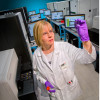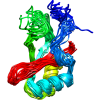Biological Sciences
Better knowledge of biomolecules and processes they undergo is vital for achieving a predictive, systems-level understanding of complex biological systems that have potential use in bioenergy, carbon cycling and biosequestration, and biogeochemistry. Areas that NERSC helps to enable include:
- Research activities using genomics and systems biology to understand plants and microbes.
- Developing and applying atomistic-molecular to coarse-grained mathematical models of potential energy surfaces, characterizing these surfaces through sampling techniques and finally generating ensemble or time averaged physical properties of biological phenomena.
- Fundamental research in the redesign of microbial metabolic processes to harness their potential in the conversion of biomass to biofuels with the ultimate goal of relieving our dependency on petroleum products as well as to impact biogeochemistry phenomena.
- Simulations to unraveling functional annotations of unstructured proteins from analysis across genomic and structural relationships. This work requires comparison across large datasets as well as dynamical simulations of protein folding into three-dimensional constructs and makes use of advances in machine learning and physics based simulations.
Computational biophysics and bioinformatics performed with both greater accuracy and complexity help guide experimentation that leads to discovery of new and emergent properties arising from a systems view of biology. Advancing our ability to predict an organism’s phenotype from a genomic sequence requires an integration of computational modeling, algorithm and software development with new advances in hardware architecture.
Probing Mercury’s Partnering Preferences
Determining the relative affinities of different atoms for the mercuric ion, Hg2+, is critical to understanding its toxicity, bioavailability, transport, and environmental fate. Read More »
Joint Genome Institute (JGI)
Key Challenges: Ensuring that there is a robust computational infrastructure for managing, storing and gleaning scientific insights from the torrent of data that constantly flows from the advanced sequencing platforms at the Department of Energy Joint Genome Institute (JGI). JGI sequencing capacity exceeds 40 billion DNA base pairs per year and is growing at a rate that exceeds computer hardware improvements, with exponential increases in computation and storage needed. JGI will generate… Read More »
Molecular Dynameomics
Over 11,000 protein folding simulations are now available in the world’s largest public database of protein structures. These simulations aim to provide a broad knowledgebase of structural pathways to support research in bioenergy production, environmental remediation, and carbon cycling. Read More »










